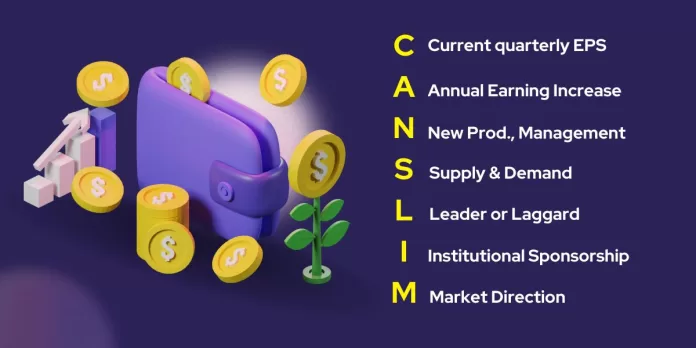There are two methods for analysing stocks before investing in them: fundamental analysis and technical analysis. Both methods have their pros and cons. Fundamental analysis helps investors determine which companies to buy. On the other hand, technical analysis guides when to buy stocks with solid fundamentals.
Have you ever wondered what would happen if we used both methods and filtered the best stocks to invest in? This approach is known as ‘technofunda.’
In this article, we are going to explore a famous technique for identifying the best companies that focus on both technical and fundamental analysis. This technique is known as CANSLIM and was founded by William J. O’Neil, the renowned author of “How to Make Money in Stocks.” Let’s explore the method.
CANSLIM is a process that investors can use to identify stocks poised to grow faster than average. Each letter in the acronym stands for a key factor to look for when purchasing shares.
C: Current quarterly earnings per share should have shown a sharp increase compared to the same quarter of the previous year. Generally, investors using this method seek EPS growth of at least 18% to 20%, with higher growth being even more desirable. According to him, profit gains of 5% to 10% are often insufficient to drive a significant price movement in a stock. Moreover, a company that exhibits only a modest increase, such as 8% or 10%, is more prone to potentially reporting lower or slower earnings in the following quarter.
A: Annual Earning Increase seeks annual EPS that has increased for each of the last three years. Ideally, you wouldn’t want earnings to decline in the second year, even if they rebound to a record high in the following year. It’s the combination of robust earnings in recent quarters along with a history of consistent growth in recent years that characterizes an exceptional stock or at the very least, one with a higher likelihood of success in a rising overall market. The companies you select should exhibit an annual rate of earnings growth at levels of 25%, 50%, or even 100% or higher. This helps you quickly weed out approximately 80% of the stocks within any industry group.
N: New products, management, or positive new events that drive the company’s stock to reach new highs. Look for companies that have introduced significant new products or services or have experienced positive changes due to new management or improved industry conditions. Then, consider purchasing their stocks when they are emerging from well-analyzed price consolidation patterns and are either close to or have already reached new price highs with increased trading volume.
S: Supply and Demand emphasize buying when stock demand exceeds supply. It’s challenging to influence the price of a stock with 5 billion shares outstanding because the supply is so extensive. To initiate a significant rally in these shares, a substantial volume of buying, or demand, would be necessary. Conversely, it only takes a moderate level of buying to drive up the price of a stock with 50 million shares outstanding, which represents a comparatively smaller supply.
Look for companies actively repurchasing their own stock in the open market; this reduces the number of outstanding shares and typically suggests that the company anticipates improved sales and earnings in the future. The most effective way to gauge a stock’s supply and demand is by monitoring its daily trading volume.
L: Leader or Laggard, it places emphasis on stocks that exhibit Relative Strength ratings of 80 or higher. Therefore, the rule for those who aspire to achieve substantial success in the stock market is to seek out true leaders and steer clear of laggards and associated plays.
Avoid purchasing stocks with Relative Strength around 40, 50, or 60. Investing in laggard stocks rarely proves profitable, even if they appear to be attractively priced. Focus your investments on market leaders and restrict your purchases to them. If you find yourself down 8% or more below the purchase price on your laggard stocks, consider exiting to minimize the risk of significant losses.
I: Institutional Sponsorship, Purchase stocks that are backed by at least a few institutional sponsors that are big financial institutional investors with above-average recent performance records and have seen an increase in institutional ownership in recent quarters. Exercise caution with stocks that are heavily owned by institutions, as it’s preferable to enter the market before significant institutional investments have been made.
M: Market Direction, to make informed investment decisions, start by reviewing market averages daily to ascertain the market’s direction. However, it’s important to note that following the other criteria is just as vital as understanding the market direction. Even if you meet all the other requirements, the first step is to determine whether the market is bullish or bearish. Keeping an eye on market indexes will help you gauge the market’s direction.
Learning to accurately interpret the daily price and volume movements of market indexes, as well as the performance of individual market leaders, is essential. This knowledge can significantly impact your success in investing. Staying in sync with the market is crucial because it doesn’t pay to be out of step with its trends.
Disclaimer: This blog has been written exclusively for educational purposes. The securities mentioned are only examples and not recommendations. It is based on several secondary sources on the internet and is subject to changes. Please consult an expert before making related decisions.


